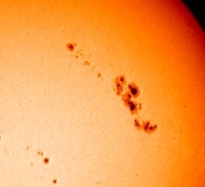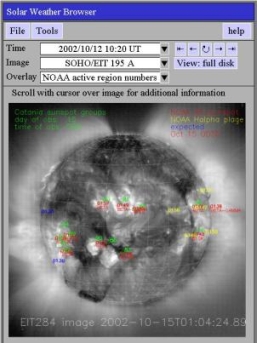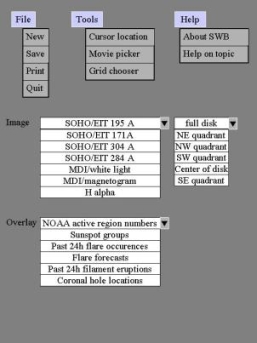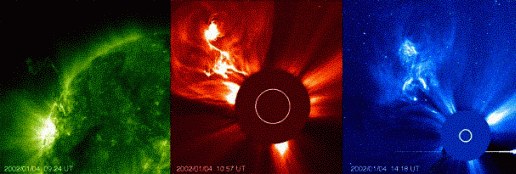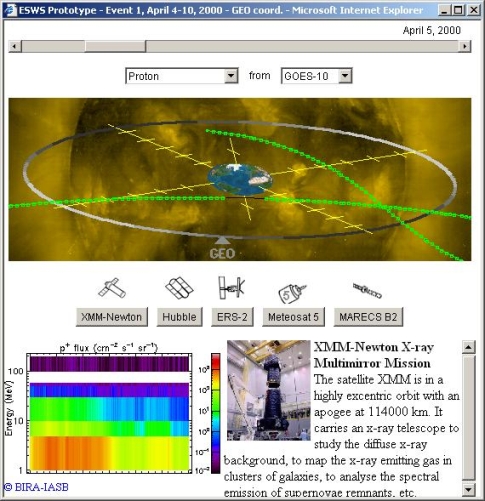| GSP Study Archive |
|---|
| Space Weather Studies |
| Applications Pilot Project |
| Feasibility Studies |
| CDF Space Weather Study |
| Past Workshops |
| Past Publications |
 SIDC
SIDC
Solar Influences Data analysis Center
Developer
Royal Observatory of Belgium
Technical Group
Ionospheric Effects & Activity Forecast
SDA objective
An operational service providing monitoring, alerts and forecasts of solar and geomagnetic activity and GPS accuracy. SIDC includes The Space Weather Yellow Pages, a user-friendly tool implementing a centralised, automated retrieval system for space weather data. It is a series of cross-referenced catalogues that references institutions, satellites, ground missions, detectors, physical parameters,... related to the measurements of the space environment components, coupled with a system that automatically retrieves, stores and disseminates the referenced data.
Products
SIDC offers several products including:
- Solar weather browser
- GPS service over Belgium.
- Computer Aided CME Tracking (CACTUS).
- Real time alerts (incl. All quiet alert).
- Space weather yellow page
- Daily solar weather report (1 for professional and 1 for public user).
- Solar highlight.
Link to Project WebSite
SDA description
Solar activity is the main driver of space weather. The Earth is orbiting within the outer atmosphere of our home star, the sun. Despite its apparent invariable, simple, spherical shape, we now know that the Sun is variable in many ways. Energetic solar phenomena such as flares and coronal mass ejections have an impact on the space environment of the Earth through different physical connections. Solar activity spans a wide range of timescales, from the secular modulation of the well-known 11-year solar activity cycle, over the 27 days of solar rotation, down to sub-second timescales during eruptions. Monitoring this solar activity and evaluating its likely consequences for the near-Earth environment thus requires both a long-term commitment as well as daily dedication to follow up the ongoing dynamics in the solar atmosphere. Only a permanent service center that specializes in solar monitoring and solar activity forecasting and that has extensive access to solar data can span these wide requirements. The ‘Solar Influences Data analysis Center’ (SIDC) at the Royal Observatory of Belgium (ROB) will perform this task within the ESA pilot project. The SIDC undertakes to provide expert and timely information on and assessment of solar dynamics and its likely relevance for the Earth environment to the other European centers included in the ESA network, but also to an extensive set of direct users of the service.
 |
|
Fig. 1. A sunspot group, observed on 30 March 2001 in white light by the ground-based telescope of the SIDC. |
Fig. 2. The International Sunspot Index. Monthly updated figures are freely available at http://sidc.oma.be. |
White-light observations of the solar photosphere are a simple but important way to characterize solar activity. The 11-year solar activity cycle is the most prominent source of solar variability. The existence of this cycle has been known for centuries due to observations of sunspots on the solar surface. The sunspot index is the oldest solar index measuring solar activity and is used for many studies on the cyclical behaviour of the Sun. The International Sunspot Index has been statistically deduced at the SIDC since 1981 on the basis of data provided by a worldwide network of about 80 (professional and amateur) observing stations.
|
Fig. 3. A bright solar flare, captured by the SOHO/EIT 195Å instrument on 1998 May 2. |
Sunspots provide a good measure for the solar activity cycle, but certainly do not constitute its most relevant manifestation. During solar maximum, the sun generates a large number of energetic eruptions such as solar flares. Solar flares produce intense electromagnetic radiation and high-energy particles, and may be associated with global plasma expulsions from the solar corona known as Coronal Mass Ejections (CMEs). These have the potential of causing severe damage to human technology in space and on the ground and to hamper communication systems. Increased fluxes of high-energy particles, for example, are detrimental for Earth-orbiting satellites and expose airplane crews and passengers to enhanced doses of radiation. Disturbances in the solar wind interact with the Earth’s magnetosphere, causing geomagnetic storms that, amongst other things, disturb GPS signals. All these effects form part of what is now commonly called ‘Space Weather’. The SIDC operates a service to help users reduce the impact of space weather on activities of human interest. In addition to its long-term monitoring of the solar activity cycle through the International Sunspot Number, the SIDC provides short-term (3-day) forecasts of solar activity and its impact on the space environment of the Earth. In the framework of the ESA Space Weather Pilot Project, this daily solar monitoring and forecasting activity will be extended and diversified, e.g. by developing a user-friendly interface to solar data, the Solar Weather Browser (Fig.4).
Fig. 4 Design template of the Solar Weather Browser (SWB, left) and some foreseen menu options (right). The final definition of the SWB software will be implemented after consultation with the users.
 White-light sunspot observations help in predicting energetic
solar events, but today, thanks to space missions such as e.g. SOHO, GOES and
ACE, a much wider range of observations
is available to characterize the solar variability on the level of radiation,
particle fluxes, and plasma flows. The SIDC scientists have been co-investigators
in the EIT/LASCO consortium since the beginning of the SOHO space mission.
This allows the use of EIT
and LASCO data for
the SIDC event reports and forecasts. CMEs, for example, are now routinely
registered by the LASCO coronagraph, and an automated CME detection tool,
CACTUS, is being
developed and will be integrated into the service.
White-light sunspot observations help in predicting energetic
solar events, but today, thanks to space missions such as e.g. SOHO, GOES and
ACE, a much wider range of observations
is available to characterize the solar variability on the level of radiation,
particle fluxes, and plasma flows. The SIDC scientists have been co-investigators
in the EIT/LASCO consortium since the beginning of the SOHO space mission.
This allows the use of EIT
and LASCO data for
the SIDC event reports and forecasts. CMEs, for example, are now routinely
registered by the LASCO coronagraph, and an automated CME detection tool,
CACTUS, is being
developed and will be integrated into the service.
|
Fig. 5. A solar eruption, captured by the EIT and LASCO instruments onboard
the joint ESA/NASA space mission SOHO on Jan. 4 2002. |
The Sun’s behavior is the most important origin of Space Weather but the
Earth environment is the place where the consequences of Space Weather for
mankind begin. The mutual interactions between the solar wind, the magnetosphere,
the ionosphere and the thermosphere lead to effects on the ground. These
effects have been observed and studied since a long time by three Belgian
institutions: the Royal Observatory
of Belgium (ROB), the Royal Meteorological Institute (RMI) and the
Belgian Institute for Space Aeronomy (BIRA). Extensions to the current SIDC
services towards the assessment of some of the implications of solar activity
for human technology are an inherent part of the project and will be accomplished
in close ties between these 3 neighboring institutes.
The Royal Meteorological Institute (RMI) brings in the ground-based infrastructure deployed since 1956 in the geophysical station of Dourbes. This infrastructure includes, in particular, ionospheric soundings and geomagnetic measurements. These data will be processed in collaboration with the GPS section of the Royal Observatory of Belgium (ROB) to serve the particular needs of the GPS user community. In practice, the ionospheric activity will be monitored in near real-time. GPS users will receive a warning when increased ionospheric activity due to Space Weather effects could affect the reliability of GPS positioning and navigation. The Belgian Institute for Space Aeronomy (BIRA) will contribute the “Space Weather Yellow Pages” (SWYP), a prototype software for retrieval of space weather data through the web, building upon technology developed within the widely known SPENVIS project. The Space Weather Yellow Pages (SWYP) is a user-friendly tool implementing a centralised, automated data retrieval system where issues as data location, format, and accessibility are transparent to the user. It is a series of cross-referenced catalogues that references institutions, satellites, ground missions, detectors and physical parameters related to measurements of space environment components, coupled with a system that automatically retrieves, stores and disseminates the referenced data. In the framework of this project, a scientific editor panel will be set up in order to maintain, update and supplement the database. The SWYP will be integrated in the SIDC web interface.
Finally, CREACTION INT., the Belgian correspondent of the ESA SPACELINK GROUP, shall participate as consultant partner for industrial and business support and actively engage in developing and maintaining industrial awareness of the impact of space weather on their activities.
Contact / Manager
Ronald van der Linden (Project Manager)
| Address: |
Royal Observatory of Belgium |
| E-mail: | Ronald.VanderLinden@oma.be |
| Telephone: | +32-2-3730491 |
